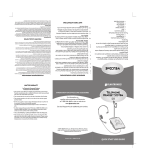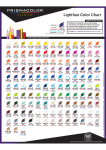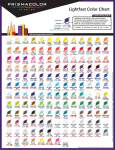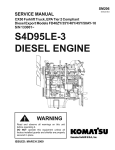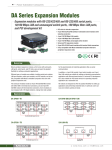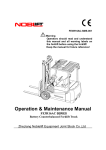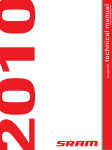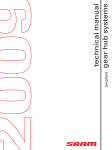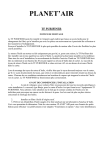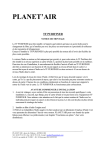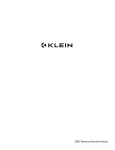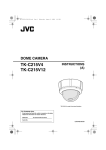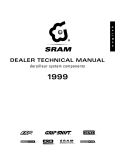Download red / force / rival
Transcript
2008 NEW TECH. SPECIFICATIONS ROAD / MTB COMPONENTS ENGLISH Caution: This New Technical Specifications are intended for bicycle factories and wholesalers only! © Copyright SRAM Corporation 2007 Publ. No. 95.3115.003.000 E Information may be enhanced without prior notice. Released March 2007 SRAM Technical Documentation, Schweinfurt/Germany Teflon is a trademark of E.I. DuPont de Nemours and Co. EXA-Drive is a trademarks of Campagnolo S.R.L., Italia. Grilon is a trademark of EMS-Chemie AG, Switzerland. Shimano, HG, IG, DURA-ACE are trademarks of Shimano Inc., Japan. TABLE OF CONTENTS ROAD / MTB COMPONENTS ROAD COMPONENTS Red / Force / Rival · Rear derailleurs 3 New version Red Red / Force / Rival · Front derailleurs 6 New version Red Red / Force / Rival · Double Tap Shifters 10 New version Red TT TT Shifters 12 All new TT TT Brake Levers 13 All new Red / Force / Rival · Cranksets with Bottom Bracket 14 New version Red Red / Force / Rival · Dual Pivot Road Calipers 16 New version Red Cassettes · Road 18 New version OG 1090 Power Chains · Road 20 New versions PC 1050 / PC 1030 MTB COMPONENTS X.0 / X-9 / X-7 / X-5 / SX 4 / 3.0 · Rear derailleurs 23 New version X-5 X-9 / X-7 / X-5 · Low Clamp Front derailleurs 27 New version X-5 X-5 / Centera · Twist shifters 30 New version X-5 X-7 / X-5 / Attack · Trigger shifters 32 New version X-5 Cassettes 34 New version PG 950 New Technical Specifications 2008 · Rev. A 1 2 New Technical Specifications 2008 · Rev. A RED / FORCE / RIVAL · REAR DERAILLEURS TECHNICAL DATA / ASSEMBLY REQUIREMENTS ROAD W W NNEE Red Speeds Shifter Compatibility Cogsets Compatibility R E D F O R C E Chains Cranks / Chainrings Cable & Housing 10 Force Rival 10 10 SRAM Double Tap shifters (Red / Force / Rival) SRAM 10 speed and other 10 speed Shimano® cogsets (largest Cog maximum 28 teeth) SRAM 10 speed Power Chains PC 1090R / PC 1090 / PC 1070 / PC 1050 / PC 1030 and Shimano® 10 speed chains 10 speed compatible, 53-39 / 50-34 / 50-36 / 48-34 / 52-36 High quality 1.1 mm shifting cable and 4 or 5 mm compressionless housing, high quality, with non-sealed end caps of Chain Capacity maximum diameter 5.8 mm and maximum length 16 mm Total 31 T 31 T 31 T Max Sprocket 28 T 28 T 28 T Min Sprocket 11 T 11 T 11 T Front Difference 16 T 16 T 16 T Titanium Steel Steel Ceramic cartridge bearing Cartridge bearing Cartridge bearing Yes Yes Yes 158 g 176 g 186 g B-Knuckle Forged Aluminum Aluminum Aluminum Outer Link Forged Aluminum Aluminum Aluminum Inner Link Carbon Magnesium Aluminum Outer Cage Carbon Carbon Aluminum Inner Cage Carbon Aluminum Aluminum Aluminum Aluminum Aluminum Parallelogram Spring Pulleys R I V A L Direct Mount Design Weight Hanger Bolt DERAILLEUR ANATOMY 1 frame hanger bolt limit screws barrel adjuster fin / cable guide cable anchor bolt 12.7 mm ± 1 cable anchor washer 2 To bottom bracket center R2 L R1 90° A FRAME DIMENSIONS (see figure 1 and 2) For optimal rear derailleur performance, the recommended rear derailleur hanger length (L) should be 26 – 28 mm. L X A R1 R2 T 26 28 6 – 10 8 – 10 30˚ – 35˚ 30˚ – 35˚ 8.5 max 8.5 max 11.5 – 12.5 11.5 – 12.5 7–8 7–8 X Chainstay length ≥ 405 mm New Technical Specifications 2008 · Rev. A 3 RED / FORCE / RIVAL · REAR DERAILLEURS ASSEMBLY ASSEMBLY 1 Advice: Check the rear derailleur hanger alignment. A bent rear derailleur hanger will result in inaccurate index shifting. 5 mm 8 – 10 Nm 70 – 85 in.lbs. • Attach the rear derailleur to the frame’s rear derailleur hanger using a 5 mm hex head wrench (Fig. 1). • Check that the b-adjust washer tab is clear of the rear derailleur dropout tab (Fig. 2). • Tighten the 5 mm hex hanger bolt to 8 – 10 Nm (70 – 85 in.lbs.) (Fig. 1). CHAIN LENGTH • Bypassing the rear derailleur, run the chain around the largest cog/large chainring combination (Fig. 3). • Add 2 LINKS or 1 link + connection link to this length for proper chain length. 2 L I M I T S C R E W S A D J U S TMENT • View the rear derailleur and pulleys from behind the rear of the bicycle (Fig. 4). • Turn the limit screw marked ’H’ on the outer link of the derailleur to align the upper guide pulley center with the outboard edge of the smallest cog (Fig. 4). • While turning the crank, push the rear derailleur towards the larger cogs by hand. • Align the upper guide pulley under the largest cog, center to center, by turning the limit screw marked ’L’ on the outer link (Fig. 4). 3 C H A I N G A P A D J U S TMENT Chain gap is the distance between the upper guide pulley and the cog the chain is riding on. Optimal chain gap is small enough to allow quick, efficient shifts to and from any cog, but large enough to allow smooth shifts to and from the largest cog. • Shift the chain to the small chain ring. • Check the chain gap between the tip of the smallest cog and the tip of the upper guide pulley. While turning the crank, push the rear derailleur by hand to the largest cog and check the chain gap in this position. (Fig. 5). • Using a screw driver, turn the b-adjust screw until the minimum chain gap in either position equals approximately 6 mm. Advice: • Setting the chain gap at this point of your installation may be considered a rough estimate. Precision index shifting may require small changes of the b-adjustment while setting the proper cable tension. • Do not use the b-adjust screw to adjust the rear derailleur to act as a chaintensioning device or to prevent chain suck. This increases the chain gap causing poor shifting performance. (2 Links) 4 4 New Technical Specifications 2008 · Rev. A RED / FORCE / RIVAL · REAR DERAILLEURS ASSEMBLY ROAD INDEX SHIFTING ADJUSTMENT 5 • Check that the chain and the rear derailleur are in the smallest cog position. • Cut the rear piece of cable housing. Make sure that it is not too short or long (Fig. 6). • Make sure the shifter cable is fully released (hardest (highest) gear at rear shifter). • Turn the rear derailleur barrel adjuster clockwise fully into the derailleur, then back it off 1 full turn. • Feed the rear shifter cable through the rear derailleur cable housing, stops and cable guides. • Thread the cable through the rear derailleur barrel adjuster and around the cable guide on the fin (Fig. 6). • Pull the cable tight and position it under the cable anchor washer. • Tighten the 5 mm hex cable anchor bolt to 4 – 5 Nm (35 – 45 in.lbs.). 6 mm (1/4" ) min. 6 • Rapidly shift the chain and derailleur up and down the cassette several times. If the cable slips repeat the two former steps. • Shift the chain to the smallest cog. • While pedaling, move the shifter up one detent. – If the chain hesitates or does not shift to the second cog, increase the cable tension by turning the derailleur barrel adjuster counterclockwise. – If the chain shifts beyond the second cog, decrease the cable tension by turning the derailleur barrel adjuster clockwise. • Repeat the two former steps until shifting and cable tension is accurate. • While turning the crank, shift the chain up and down the cassette and chain rings several times to ensure that your derailleur is indexing smoothly. 5 mm 4 – 5 Nm (35 – 45 in.lbs.) TROUBLESHOOTING 7 Spray Lube Spray Lube New Technical Specifications 2008 · Rev. A Problem Chain jumps from smallest sprocket to frame dropout. Cause High gear limit screw is not adjusted properly. Difficult or impossible to shift chain onto smallest sprocket. High gear limit screw is not adjusted properly. Chain jumps over largest sprocket and falls between the spokes and largest sprocket or inner cage plate scrapes on spokes. Delayed shifting. Low gear limit screw is not adjusted properly. Rear derailleur or derailleur hanger is bent. Clearance between guide pulley / sprocket is too large. Clearance between guide Rough shifting behavior. pulley / sprocket is too small. Shifts more gears onto small- Shift cable insufficiently tensioned. er sprockets as intended Shift cable insufficiently Delayed shifting onto tensioned. larger sprocket Shift cable is too tight. Delayed shifting onto smaller sprocket Excessive cable friction, pinched or poorly routed cable. Remedy Turn in screw H until the guide pulley is aligned with the smallest sprocket. Unscrew screw H until the guide pulley is aligned with the smallest sprocket. Turn in screw L until the guide pulley is aligned with the largest sprocket. Straighten or replace. Adjust b-adjust screw by rotating counterclockwise. Adjust b-adjust screw by rotating clockwise. Turn barrel adjuster on the shifter counterclockwise. Turn barrel adjuster on the shifter counterclockwise. Turn barrel adjuster on the shifter clockwise. Lubricate or replace cable and housing. Check for excessive bending of cable housing. 5 RED / FORCE / RIVAL · FRONT DERAILLEURS TECHNICAL DATA / ASSEMBLY REQUIREMENTS W W NNEE Red Force Rival Yes Yes Yes 31.8 mm with band adaptor Yes Yes 34.9 mm with band adaptor Yes Yes Rear Compatibility 10 speed 10 speed 10 speed Shifter Compatible SRAM Double Tap Shifter (Red / Force / Rival) Clamp Braze-on Compatibility R E D F O R C E Cogsets Chains Cranks / Chainrings Cable & Housing SRAM 10 speed and other 10 speed Shimano® cogsets (largest Cog maximum 28 teeth) SRAM 10 speed Power Chains PC 1090R / PC 1090 / PC 1070 / PC 1050 / PC 1030 and Shimano® 10 speed chains 10 speed compatible, 53-39 / 50-34 / 50-36 / 48-34 / 52-36 High quality 1.1 mm shifting cable and 4 or 5 mm compressionless housing, high quality, with non-sealed end caps of maximum diameter 5.8 mm and maximum length 16 mm Maxim. Tooth Difference Cable Routing R I V A L Chainstay Angle Mount Type Chain Line 16T Bottom Pull 16T Bottom Pull 61 – 66° 61 – 66° 61 – 66° Down Swing Down Swing Down Swing 44,5 mm 44,5 mm 44,5 mm Braze-on: 58 g / 31.8 mm: N/A / 34.9 mm: NA Braze-on: 88 g / 31.8 mm: 102 g / 34.9 mm: 103 g Braze-on: 88 g / 31.8 mm: 102 g / 34.9 mm: 103 g Forged Aluminum Forged Aluminum Forged Aluminum Outer Link Aluminum Aluminum Aluminum Inner Link Aluminum Aluminum Aluminum Hardened Titanium Steel Chrome Plated Steel Chrome Plated Weight Band Material Design 16T Bottom Pull Chain Cage BRAZED-ON FRAME DEFINITIONS 1 in. mm 16 m mm 150 ct and gs) n mpa inri (Co rd Cha da Stan (see Fig. 1) The contact surface of the braze-on boss should be aligned parallel with the centerline of the seat tube. m 6m R 7. R m 5m m 25 m mm 8.7 6 New Technical Specifications 2008 · Rev. A RED / FORCE / RIVAL · FRONT DERAILLEURS TECHNICAL DATA / ASSEMBLY REQUIREMENTS ROAD FRAME DIMENSIONS 2 (see Fig. 2) The seat tube should be positioned in the center of the bottom bracket shell. α Length of chainsty: • Road L > 405 mm. • Rear frame alignment must be symmetrical. Chainstay angle: α = 61° – 66°. 15 mm max. 7 mm max. Chainline: 44.5 mm. (Measurement from the center of the bracket to the center of the two chainrings.) 75 mm 110 mm L Hatched area can be used by frame design. 19.5 mm max. 34 .9 mm 15 mm max. 155 mm 105 mm 8.5 mm Ø 15 mm max. 3 NECESSARY CLEARANCE FOR CLAMP VERSION C (see Fig. 3) Be sure to leave enough clearance between bottle cage holes and clamp location. D Necessary clearance see Fig. 2 Large Chainring A B Clamp band position 48 T 50 T 52 T 53 T A 135 mm 139 mm 143 mm 145 mm B 152 mm 156 mm 160 mm 162 mm Clamp version Necessary clearance New Technical Specifications 2008 · Rev. A Red Force / Rival C 9 mm 4 mm D 1 mm 4 mm 7 RED / FORCE / RIVAL · FRONT DERAILLEURS ASSEMBLY ASSEMBLY • Tighten the 5 mm hex cable anchor bolt to 5 Nm (44 in.lbs.). • Only version Red: Mount the front derailleur to the clamp adaptor. Tighten the • Shift the chain up and down the chain5 mm hex clamp bolt to 4 – 5 Nm (35 – 44 rings several times to take out initial in.lbs.) (Fig. 1). slack in the cable. • Attach the front derailleur to the seat • If necessary re-tension the cable and tube. tighten cable anchor bolt. Direct mount version (see Figure 2): use upper thread for compact chainrings (50-36 / 50-34 / 48-34) or lower thread for H I G H L I M I T A D J U S T M E N T standard chainrings (53-39 / 52-36). (see Fig. 7) 1 1. 2. 5 mm 4 – 5 Nm 35 – 44 in.lbs. compact 50-36 / 50-34 / 48-34 2 • Adjust the position along the seat tube so that clearance between the front derailleur cage and the large chainring is 1 – 3 mm (Fig. 3). At the same time, align the front derailleur cage outerplate to be parallel with the chainrings (Fig. 4). standard 53-39 / 52-36 • Tighten the 5 mm hex clamp bolt to 4 – 5 Nm (35 – 44 in.lbs.) for direct mount version or 3 – 4 Nm (27 – 35 in.lbs.) for version with band adatpor or 5 – 7 Nm (44 – 62 in.lbs.) for clamp version. 5 mm 4 – 5 Nm 35 – 44 in.lbs. LOW LIMIT ADJUSTMENT (see Fig. 5) • Place the chain on the largest rear cog and the small front chainring. • Adjust the low limit screw (Fig. 5) so that the chain is positioned close to the inner cage plate without actually touching it (clearance between the front derailleur cage inner plate and the chain is 0.5 – 1 mm). 3 1 – 3 mm • Set the chain to the smallest rear cog and the large front chainring. • Adjust the high limit screw so that clearance between the front derailleur cage outer plate and the chain is 0.5 – 1 mm. INDEX SHIFTING ADJUSTMENT (see Fig. 8) Version Red: Shift the chain onto the biggest rear sprocket and big chainring. Make sure the left shifter is set in the middle position – if the chain scrapes against the inner cage plate, turn the adjusting barrel on the frame until the chain shifts smoothly and free of obstruction. Versions Force / Rival: Shift the chain onto the smallest rear sprocket and small chainring. Make sure the left shifter is set in the middle position – if the chain scrapes against the inner cage plate, turn the adjusting barrel on the frame until the chain shifts smoothly and free of obstruction. CONNECTING CABLE • Check that the chain and the front derailleur are in the small chainring position. 4 Clamp version 5 mm 5 – 7 Nm 44 – 62 in.lbs. • Make sure the shifter cable is fully released (easiest (lowest) gear for front shifter). • Turn the barrel adjuster on the frame fully into the housing, then turn 1 full turn back. 5 Version with clamp adaptor 5 mm 3 – 4 Nm 27 – 35 in.lbs. • Feed the front shifter cable through the cable housing and stops. Route cable through a cable guide beneath the bottom bracket. • Run the cable under the cable anchor washer and hold taut (Fig. 6). 8 New Technical Specifications 2008 · Rev. A RED / FORCE / RIVAL · FRONT DERAILLEURS ASSEMBLY ROAD ADVICE 6 Avoid using extreme gear combinations as these combinations cause noise and excessive wear! 5 mm 5 Nm 44 in.lbs. 7 TROUBLESHOOTING Cause Problem Shifter actuated, chain fails Shift cable incorrectly clamped. to change chainring. 8 Chain falls over large / small chainring. Force required to actuate gears is too high. Crank collides with front derailleur. Remedy Check shift cable and correct as necessary (cable clamp; cable housing stops; cable recess in shifter; cable tension). High / low limit screw poorly Correct limit screws. adjusted. Clearance between cage Correct position (1 – 3 mm). and large chainring is too big / small. High / low limit screw poorly Correct limit screws. adjusted. Excessive cable friction, Lubricate or replace cable pinched or poorly routed and housing. Check for cable. excessive bending of cable housing. High gear limit screw Correct high limit screw. incorrectly adjusted. Cage not parallel with chain- Correct the front derailleur ring. position. 9 New Technical Specifications 2008 · Rev. A 9 RED / FORCE / RIVAL · DOUBLE TAP SHIFTERS TECHNICAL DATA / ASSEMBLY REQUIREMENTS R E D Shifter Type Speeds Compatibility F O R C E Red Version Double Tap Shifter Double Tap Shifter Double Tap Shifter Double Tap Shifter Front Rear Front Rear Front Rear 2 10 2 10 2 10 SRAM Red / Force / Rival Crankset SRAM Red / Force / Rival Brakes Rival Double Tap Shifter Derailleur SRAM Red / Force / Rival Dual Pivot Road calipers, Avid Shorty 4/6 cantilevers, Avid BB7 Road and most common Road caliper brakes Shifter Cable high quality 1.1 m m shifting cable and 4 or 5 mm compressionless housing, high quality, with non-sealed end caps of maximum Brake Cable 1.6 mm high quality brake cable with road-style cable end and brake cable housing with end caps diameter 5.8 mm and maximum length 16 mm Cable Pull Release R I V A L Force Double Tap Shifter Double Tap Double Tap Double Tap Double Tap Double Tap Double Tap Teflon Coat. Stainl. Steel Teflon Coat. Stainl. Steel Teflon Coat. Stainl. Steel Teflon Coat. Stainl. Steel Stainless Steel Stainless Steel Brake and shift lever Brake and shift lever None None None None Gear Indication None None None None None None Barrel Adjuster None None None None None None 22.1 – 22.3 mm 22.1 – 22.3 mm 22.1 – 22.3 mm 22.1 – 22.3 mm 22.1 – 22.3 mm 22.1 – 22.3 mm 280 g 280 g 303 g 303 g 340 g 340 g Cable Reach Adjust Clamping Diameter Weight RED / FORCE / RIVAL · DOUBLE TAP SHIFTERS ASSEMBLY ASSEMBLY 1 3 • Flip hood cover by hand. Slide shifter onto handlebar (Fig. 1). Tighten the 5 mm hex clamp bolt to 6 – 8 Nm (53 – 70 in.lbs.) (Fig. 2). • Feed the shifter cables and brake cables through the cable housings and stops. Make sure the shifter cable is fully released (easiest (lowest) gear for front shifter or the hardest (highest) gear for rear shifter). Red shifters: Choose the one shift cable exit which fits best for your handlebar (Fig. 3). It may be helpfull to use a pick. There is no need to disassemle the shifter. 2 • Replace hood cover. • Attach the front/rear shifter cable to the front/rear derailleur and adjust indexing per derailleur instructions. Attach the front/rear brake cable to the front/rear brake and adjust per brake instructions. Caution: Always check the front and rear brake levers for proper operation. 5 mm 6 – 8 Nm 53 – 70 in.lbs. 10 New Technical Specifications 2008 · Rev. A RED / FORCE / RIVAL · DOUBLE TAP SHIFTERS USE 1 0° X° CLICK XX° CLI CL CLICK CK ICK 0 ROAD USE BRAKE LEVER SHIFTER Caution: Always check the front and rear brake levers for proper operation! • Move the small shift lever inward slightly and an upshift to a harder (higher) gear is initiated (Fig. 1). Push the same lever farther inward and you’re shifting up to three shifts to easier (lower) gears (Fig. 1). The shifters also offer specific operations: • Upshifting while sprinting: 2 • Shifting from the hoods: REACH ADJUST Brake lever (Fig. 3): • Flip hood cover by hand. • Use the small hex clamp bolt (2 mm) to set the reach adjust of the brake lever. Caution: After any change on the reach adjust of the brake lever allways re-adjust the shift lever to avoid interference between the two levers. Shift lever (Fig. 4): Pull the shift lever toward the handlebar While pushing turn the cam plate to set the reach adust. It may be helpfull to use a pick. Caution: Always check the front and rear brake levers for proper operation! • Shifting from the drops: 3 • The left hand shifter offers a trim function for the front derailleur to allow the chain running smoothly in extreme positions. Force and Rival shifters: Shift position 1 and 2 is for the small chainring. Shift position 3 is for the large chainring. Red shifter: Shift position 1 is for the small chainring. Shift position 2 and 3 is for the large chainring. 4 New Technical Specifications 2008 · Rev. A 11 TT SHIFTERS TECHNICAL DATA / ASSEMBLY REQUIREMENTS TT Shifter Version T T Speeds Derailleur Compatibility S H I F T E R Shifter Type Crankset Time Trial Shifter Time Trial Shifter Front (Friction) Rear (Index) 2 10 SRAM Red / Force / Rival SRAM Red / Force / Rival SRAM Red / Force / Rival SRAM Red / Force / Rival Shifter Cable high quality 1.1 m m shifting cable and 4 or 5 mm compressionless housing, high quality, with non-sealed end caps of maximum Brake Cable 1.6 mm high quality brake cable with road-style cable end and brake cable housing with end caps diameter 5.8 mm and maximum length 16 mm Bar Inner Diameter Cable 19.2 – 22.5 mm / Minimum depth 35 mm Teflon Coat. Stainl. Steel Teflon Coat. Stainl. Steel Gear Indication None None Barrel Adjuster None None Weight 138 g 138 g TT SHIFTERS ASSEMBLY ASSEMBLY 1 • Remove screw to allow shift assembly to be removed from housing and to access the mounting screw (Fig. 1). Advice: The shift assembly comes off as one piece and there is no opportunity to loose any parts unless the other screw is removed. • Push the shifter housing onto the handlebar (Fig. 2). 2 4 5 Nm 44 in.lbs. 5 • Tighten the the clamp screw using a 5 mm Allen wrench, torque 8 Nm (70 in.lbs.) (Fig. 3). • Re-assemble the shift assembly and reinstall the screw, tightening torque 5 Nm (44 in.lbs.) (Fig. 4). • Torque the friction adjust screw (center of red washer) to 2 Nm (18 in.lbs.) minimum. Higher torque can be applied to increase torque to shift for rider preference (Fig. 5). 3 min. 2 Nm min. 18 in.lbs. 6 • Feed the new cable through the cable entry (1) and out the shifter (Fig. 6). • Feed the new cable through the cable housing and cable stops. 5 mm 8 Nm 70 in.lbs. 12 • Pull the cable snug. Make sure that the cable nipple is firmly seated in the cable holder. 1 • Attach the cable to the derailleur and adjust indexing per derailleur instructions. New Technical Specifications 2008 · Rev. A TT BRAKE LEVERS TECHNICAL DATA / ASSEMBLY REQUIREMENTS ROAD TT Brake Lever Version Brake Lever Compatibil. Lever Size Time Trial Brake Lever Time Trial Brake Lever Left Right 5-finger 5-finger Brake compatibilty SRAM Red / Force / Rival Dual Pivot Road calipers, Avid Shorty 4/6 cantilevers, Avid BB7 Road Bar Inner Diameter 19.2 – 22.5 mm / Minimum depth 39 mm and most common Road caliper brakes Reach Adjust No No Pivot Bushing POM POM 99 g 99 g Grilon Composite Grilon Composite Carbon Comp. Carbon Comp. Weight Design T T B R A K E L E V E R TT Housing Lever TT BRAKE LEVERS ASSEMBLY ASSEMBLY 1 • Push the cable housing end cap onto the brake cable housing (Fig. 1). 1 • Insert the end of the brake cable housing into the brake lever bottom side (Fig. 2). 5 mm 8 Nm 70 in.lbs. • Push the brake lever onto the handlebar (Fig. 3). • Tighten the brake lever. 5 mm Allen wrench, torque 8 Nm (70 in.lbs.) (Fig. 4). 2 • Pull the brake handle toward the handlebar and make sure the countersunk side of the hole is visible (1). Feed the new cable through the cable holder (2), cable housing and cable stops (Fig. 5). • Pull the cable snug. Make sure that the cable nipple is firmly seated in the cable holder. 2 1 • Follow the brake manufacturer's instructions when mounting the brake cable and adjusting the brakes. 2 Caution: • Before riding, always check that all brake system components are functioning properly. • Check and correct the brake cable tension after each handle change to ensure good brake performance. New Technical Specifications 2008 · Rev. A 2 13 RED / FORCE / RIVAL · CRANKSETS W. GXP BOTTOM BRACKET TECHNICAL DATA / ASSEMBLY REQUIREMENTS R E D R I V A L Compatibility BB Thread Red Compact Force Force Compact GXP External Bearing GXP External Bearing BSA or Italian Rival Rival Compact GXP External Bearing BSA or Italian BSA or Italian Bolt Circle Diam. 130 mm 110 mm 130 mm 110 mm 130 mm 110 mm Chainring Ratio 53 / 39 T 50 / 34 – 50 /36 T 53 / 39 T 50 / 34 – 50 /36 T 53 / 39 T 50 / 34 – 50 /36 T Only compat. with SRAM 10 speed chains SRAM 10 speed chains PC1090R/PC1090/PC1070/PC1050/PC1030 and Shimano® 10 speed chains Chainline 44.5 mm 44.5 mm 44.5 mm Minimum Chainstay 405 mm 405 mm 405 mm 165 / 170 / 172.5 / 175 / 177.5 / 180 mm 165 / 170 / 172.5 / 175 / 177.5 / 180 mm 165 / 170 / 172.5 / 175 / 177.5 / 180 mm Ceramic Sealed Cartridge Bearing Sealed Cartridge Bearing Sealed Cartridge Bearing Weight 765 g 790 g BB Cup Forged Alloy Chains Crank Lengths Bearing Finish F O R C E Red BB Type 765 g Crank Arm Carbon Fibre Chainring 780 g Forged Alloy AL 7075-T6 Aluminum with TNT Finish Chainring Bolts AL 7075-T6 Aluminum 850 g 840 g Forged Alloy Carbon Fibre AL 6066 Aluminum AL 7075-T6 Aluminum with TNT Finish AL 7075-T6 Aluminum with Hard Anodizing AL 7075-T6 Aluminum AL 7075-T6 Aluminum Cranks are only compatible with GXP bottom brackets and Powerglide Chainrings by Truvativ. RED / FORCE / RIVAL · CRANKSETS W. GXP BOTTOM BRACKET ASSEMBLY NECESSARY TOOLS 1 ASE Bearing face Drive side (Right) Non-drive side (Left) GRE Threads O-Rings Bearing seal surface Note: Note: Drive side bearing seal has Non-drive side bearing seal larger inner diameter than has smaller inner diameter non-drive side seal than drive-side seal 2 • Torque wrench • 8 mm hex, 16 mm (5/8”) hex • Bottom Bracket installation tool (Truvativ GXP tool, Park™ BBT9 or equivalent) Supplies: • Grease PARTS PREPARATION • Assure the frame’s bottom bracket shell threads are clean and undamaged, there should be no paint or dirt present. Have your bottom bracket shell chased and faced by your bike shop for best results. Check to make sure the threads of your GXP bottom bracket match the threads in the bottom bracket shell of your frame. • Prepare the bottom bracket as shown in Figure 1. It may be necessary to remove the drive side seal from the spindle. Both seals should be pressed into place so that the outer lip seats firmly in the bottom bracket cup groove. Apply grease to the surfaces shown in Figure 1. • Prepare the crank spindle: – Apply grease to splines (1, Figure 2) – Apply grease to crankbolt threads (2) – Apply grease to spindle bearing race surfaces (3) • Prepare the self extracting crank bolt: Apply grease to the surfaces shown in Figure 3. 3 GREA SE 1 2 3 GREAS 14 E New Technical Specifications 2008 · Rev. A RED / FORCE / RIVAL · CRANKSETS W. GXP BOTTOM BRACKET ASSEMBLY ROAD ASSEMBLY 4 English (BSA) GRE ASE 34 – 41 Nm (301 – 363 in.lbs.) Italian (IT) 5 GREA SE 34 – 41 Nm (301 – 363 in.lbs.) 6 • Grease frame threads (Fig. 4). Thread the prepared bottom bracket into the drive side (right side) of the frame (counterclockwise to tighten English (BSA) thread or clockwise to tighten Italian thread) until the flange bottoms against the frame shell face. Torque to 34 – 41 Nm (301 – 363 in.lbs.) using a torque wrench. Refer to Figure 4. • Check the assembly for play by pulling crankarm away from frame, alternating back and forth. If the crank moves, tighten crankarm bolt until no play is detected. If maximum torque of 48 – 54 Nm (425 – 478 in.lbs.) has been achieved, remove the crankarm from the spindle, apply additional grease, and repeat installation. It may take several installations to eliminate all play. • Grease frame threads (Fig. 5). Thread the prepared left adapter cup into the non-driveside (left side) of the frame (Clockwise to tighten) until the flange bottoms against the frame shell face. Torque the left adapter cup to 34 – 41 Nm (301 – 363 in.lbs.) using a torque wrench. • Grease the pedal threads, add pedal washers (1, Figure 8), assemble and tighten the pedals to the crankarms with 31 – 34 Nm (274 – 301 in.lbs.). Caution: Drivetrain side right hand pedal-thread. Non drive side left hand pedal-thread. • Grease the inner bearing races as shown in Figure 6. Slide the right crankarm and spindle assembly through the bottom bracket until the left side splines come through the left side bottom bracket cup, and the spindle stops. Advice: • If creaking of the assembly occurs, check that all parts were torqued to specification, grease is liberally applied on all surfaces noted. Also check chainring bolts (8 – 9 Nm / 80 – 90 in.lbs.) and pedals are installed with proper lubrication and torque. • GXP seals are designed to prevent contamination and therefore must rub against their sealing surfaces. New GXP seals will feel stiff upon initial installation. This is normal. With use the seals will wear-in and loosen up. • If the crank bolt assembly has not been assembled yet, assemble it and torque as shown in Figure 7. Use a 16 mm hex (5/8”) and torque wrench to install self extractor and torque to 12 – 15 Nm (106 – 133 in.lbs.). • Assemble the left crankarm onto the bottom bracket spindle using an 8 mm hex and torque wrench and torque to 48 – 54 Nm (425 – 478 in.lbs.) as shown in Figure 8. 8 31 – 34 Nm 274 – 301 in.lbs. GREAS E 1 7 16 mm (5/8“) 12 – 15 Nm 106 – 133 in.lbs. 1 8 mm 48 – 54 Nm 425 – 478 in.lbs. 31 – 34 Nm 274 – 301 in.lbs. New Technical Specifications 2008 · Rev. A 15 RED / FORCE / RIVAL · DUAL PIVOT ROAD CALIPERS TECHNICAL DATA / ASSEMBLY REQUIREMENTS Red Compat. Version Brake Levers Brake Cable Pad Design B R A K E C A L I P. Front Force Rear Front Rival Rear Front Rear SRAM Red / Force / Rival Double Tap shifters 1.6 mm high quality brake cable with road-style cable end and brake cable housing with end caps Exchangeable Exchangeable Exchangeable Quick Release Yes Yes Yes Barrel Adjuster Yes Yes Yes Weight per Set 265 g (front and rear) 265 g (front and rear) 279 g (front and rear) 279 g (front and rear) 289 g (front and rear) 287 g (front and rear) Pivot Bolt Arms Titanium Titanium Stainless Steel Cold Forged Aluminum Cold Forged Aluminum Cold Forged Aluminum RED / FORCE / RIVAL · DUAL PIVOT ROAD CALIPERS TECHNICAL DATA / ASSEMBLY REQUIREMENTS ASSEMBLY 1 Install the brake caliper: Hold the brake so it is approximately centered on the wheel, then tighten the brake mounting nut with a 5 mm Allen wrench, tighten to 8 – 10 Nm (70 – 90 in.lbs.) (Figure 1). Position the brake pads: Adjusting the brake pad position as shown in figure 2. Toe-in, the angle of contact between the pad and the rim, can also be adjusted to optimize braking feel and performance. 5 mm 8 – 10 Nm 70 – 90 in.lbs. 2 Center the brake pads: • Loosen the m ounting nut of the caliper brake a bit (Figure 6). • Use a 12 mm wrench to precisely center the brake to the rim. • Re-tighten the brake mounting nut to 8 – 10 Nm (70 – 90 in.lbs.). Inspection: Squeeze brake lever hard 10 times to check that everything is operating correctly, then re-check the brake pad position and clearance to the rim. • Tighten the brake pad bolt with a 4 mm allen key to 5 – 7 Nm (44 – 62 in.lbs.). Connect the brake cable: • Make certain the quick release lever is in the closed position (Figure 3). • Place the cable in the groove in the cable clamp washer (Figure 4). • Squeeze the brake caliper until each brake pad is 1 – 1.5 mm from the rim. • Tighten the cable bolt to 6 – 8 Nm (53 – 70 in.lbs.). 4 mm 5 – 7 Nm 44 – 62 in.lbs. 16 • Turn the barrel adjuster to reset the shoe clearance (1 – 1.5 mm) (Figure 5). New Technical Specifications 2008 · Rev. A RED / FORCE / RIVAL · DUAL PIVOT ROAD CALIPERS ASSEMBLY For Brake Lever information please read the integrated brake shifter User Manual. 3 Caution: • Brakes are a safety-critical item on a bicycle. Improper set-up or use of brakes can result in loss of control or an accident, which could lead to a severe injury. It is your responsibility to learn proper braking techniques. Consult the user manual for your bicycle and a professional bike dealer. Practice your riding and braking techniques on a flat and level surface prior to aggressive riding. • The effectiveness of braking is dependent on many conditions over which SRAM has no control including the speed of the bicycle, type and condition of the riding surface, braking lever force, proper installation and maintenance of brakes, cables, levers, brake pads, the condition of the bike, weight of the rider, braking technique, weather, and a variety of other factors. Remember, it takes longer to stop in wet conditions. • SRAM brakes and levers are not intended for use on any motorized bicycle or vehicle. Any such use could result in a serious personal injury. • Inspect your brakes regularly for damage, and always inspect them thoroughly after any crash or severe impact. If you detect damage, please have your brakes inspected by a professional bike dealer. • Follow these instructions carefully. If you do not understand the instructions, have the installation done by a professional bike mechanic. 4 6 – 8 Nm 53 – 70 in.lbs. 5 ROAD Advice; • SRAM’s road brake pads are optimized for aluminum rims. If used with ceramiccoated or carbon rims, the brake pads will wear more rapidly. Be certain to inspect them often. • If the brake pads are worn until the grooves disappear, replace them with new pads. 6 5 mm 8 – 10 Nm 70 – 90 in.lbs. New Technical Specifications 2008 · Rev. A 17 CASSETTES · ROAD TECHNICAL DATA / ASSEMBLY REQUIREMENTS W W NNEE Road W W NNEE Application Road Technology Open Glide Open Glide Largest Cog 26 T 23 T Speeds 10 10 Chains SRAM 10 speed Power Chains PC 1090R, PC 1090, PC 1070, PC 1050, PC 1030 and Shimano® 10 speed chains Hubs Any hub with Shimano® compatible driver body (not compatible with Shimano® DURA-ACE 10 speed cassettes bodies) Cogs 11/12/13/14/15/17/19/21/23/26 11/12/13/14/15/16/17/19/21/23 Lockring torque Weight Cogs Design O G 1 0 9 0 Compatibility OG 1090 Spider 40 Nm 40 Nm N/A N/A Heat treated steel / Titan Heat treated steel / Titan Carbon Carbon Aluminum, anodized Aluminum, anodized Rivets N/A N/A Finish N/A N/A Lockring Road Road Technology Open Glide Open Glide Open Glide Open Glide Open Glide Largest Cog 26 T 26 T 23 T 25 T 25 T Speeds 10 10 10 10 10 Chains SRAM 10 speed Power Chains PC 1090R, PC 1090, PC 1070, PC 1050, PC 1030 and Shimano® 10 speed chains Cogs 12/13/14/15/16/17/19/21/23/26 11/12/13/14/15/17/19/21/23/26 11/12/13/14/15/16/17/19/21/23 12/13/14/15/16/17/19/21/23/25 11/12/13/14/15/17/19/21/23/25 Cogs Spider Lockring 40 Nm 40 Nm 40 Nm 40 Nm 40 Nm 243 g 232 g 210 g 238 g 223 g Heat treated steel Heat treated steel Heat treated steel Heat treated steel Heat treated steel Aluminum 6061 Aluminum 6061 Aluminum 6061 Aluminum 6061 Aluminum 6061 Aluminum, anodized Aluminum, anodized Aluminum, anodized Aluminum, anodized Aluminum, anodized Rivets Stainless Steel Stainless Steel Stainless Steel Stainless Steel Stainless Steel Finish Pearl Ni-Chrome Plated Pearl Ni-Chrome Plated Pearl Ni-Chrome Plated Pearl Ni-Chrome Plated Pearl Ni-Chrome Plated Compatibility W W Road NNEE W W NNEE Application Road Technology Open Glide Open Glide Largest Cog 27 T 28 T Speeds 10 10 Chains SRAM 10 speed Power Chains PC 1090R, PC 1090, PC 1070, PC 1050, PC 1030 and Shimano® 10 speed chains Hubs Any hub with Shimano® compatible driver body (not compatible with Shimano® DURA-ACE 10 speed cassettes bodies) Cogs 12/13/14/15/16/17/19/21/24/27 11/12/13/14/15/17/19/22/25/28 Lockring torque Weight Cogs Spider 40 Nm 40 Nm 243 g 242 g Heat treated steel Heat treated steel Aluminum 6061 Aluminum 6061 Aluminum, anodized Aluminum, anodized Rivets Stainless Steel Stainless Steel Finish Pearl Ni-Chrome Plated Pearl Ni-Chrome Plated Lockring 9 / 8 speed cassettes see page 58 and 59. 18 W W NNEE Any hub with Shimano® compatible driver body (not compatible with Shimano® DURA-ACE 10 speed cassettes bodies) Weight Design Road Hubs OG 1070 O G 1 0 7 0 Road W W NNEE Road Application Lockring torque Design O G 1 0 7 0 Compatibility OG 1070 New Technical Specifications 2008 · Rev. A CASSETTES · ROAD ASSEMBLY ROAD ASSEMBLY 1 The sprockets are arranged on a plastic support (Speedloader). • Remove the transportation lock. • Versions with sprockets with 11 teeth: Remove the lockring from the front and the sprocket with 11 teeth from the back of the Speedloader. • Versions with sprockets with 12 teeth: Remove the lockring from the Speedloader. • Align the spline patterns of the Speedloader with the driver of the hub and press the Speedloader against the driver (Figure 1). 2 • Push the cassette from the Speedloader onto the driver of the hub. Advice: Cassettes with carbon spiders: Make sure to mount the steel washer (thickness 1 mm) between the driver and the cassette. • Only versions with sprockets with 11 teeth: Position the sprocket with 11 teeth on the driver (Figure 2). 3 • Screw the lockring into the driver. Use a mounting tool (1, Fig. 3) (Park Tool® FR-5 or Shimano®) and a chain wrench (2, Fig. 3). Tightening torque 40 Nm (350 in.lbs.) (Figure 3). 1 Advice: Be careful not to damage the thread of the lockring by tilting. • After installing the rear wheel adjust the rear derailleur per derailleur instructions. 2 New Technical Specifications 2008 · Rev. A 19 POWER CHAINS · ROAD TECHNICAL DATA / ASSEMBLY REQUIREMENTS P O W E R Application Max. No. of sprockets Pin PC 1050 Road Road PC 1030 Road 10 only 10 only 10 only 10 only 10 only SRAM OG / HG / EXA-Drive SRAM OG / HG / EXA-Drive SRAM OG / HG / EXA-Drive SRAM OG / HG / EXA-Drive SRAM OG / HG / EXA-Drive Riveting Chrome Hardened 1 /2" x 11/128" 1 /2" x 11/128" 1 /2" x 11/128" 1 /2" x 11/128" 1 /2" x 11/128" 5.87 mm 5.87 mm 5.87 mm 5.95 mm 5.95 mm Cylindrical Cylindrical Cylindrical Flat Cylindrical Flat Cylindrical Yes Yes Yes Yes Yes 2000 N / 450 lbs. 2000 N / 450 lbs. 2000 N / 450 lbs. 2000 N / 450 lbs. 2000 N / 450 lbs. 9000 N / 2023 lbs. 9000 N / 2023 lbs. 9000 N / 2023 lbs. 9000 N / 2023 lbs. 9000 N / 2023 lbs. Weight (114 links) 257 g 265 g 265 g 277 g 277 g External Pin Plate Silver / Nickel Plated Silver / Nickel Plated Silver / Nickel Plated Silver / Nickel Plated Silver / Nickel Plated Silver / Nickel Plated Silver / Nickel Plated Grey Silver / Nickel Plated Grey Power Lock 10 Speeds Power Lock 10 Speeds Power Lock 10 Speeds Power Lock 10 Speeds Power Lock 10 Speeds Min. Tensile Strength Internal Pin Plate Connecting Method 1 Caution: Connecting method: with Power Lock only (no pin)! 9 / 8 speed chains see page 62. 20 NEW NEW Compatibility Rear Push Power Design PC 1070 Road Truvativ / HG / EXA-Drive Truvativ / HG / EXA-Drive Truvativ / HG / EXA-Drive Truvativ / HG / EXA-Drive Truvativ / HG / EXA-Drive Length 1 PC 1090 Road Compatibility Front Dimension C H A I N S NEW NEW PC 1090R New Technical Specifications 2008 · Rev. A POWER CHAINS · ROAD ASSEMBLY 1 (1 Link + Power Lock) 2 ROAD PC 1090R / PC 1090 / PC 1070 / PC 1050 / PC 1030 ( 1 / 2 " x 11 / 128 " ) Opening: Once the Power Lock is installed it can only be removed by means of a Chain tool. Chain length: (A chain tool will be required to shorten the chain.) • Replacing a worn chain: Measure the worn chain and shorten the new to the same length. • Initial assembly: Shorten the chain to the length specified by the derailleur manufacturer. SRAM derailleurs: place the chain over largest front chainwheel and largest rear sprocket and add 1 link + Power Lock (Fig.1). Caution: • Power Lock is for one-time use only! • Always use a new Power Lock when fitting a new chain. • Failure to shorten the chain properly or to lock it exactly into place may cause damage to the chain and eventually total chain failure, material damage or the rider to fall off his bicycle resulting in injury. • Worn sprockets should also be replaced when a new chain is fitted. Closing chain with Power Lock: Caution: • Use Power Lock only with SRAM chains! • Use only Power Lock to close 10 speed chains (no Pin)! • Use only Power Lock (black coloured) for PC 1090R, PC 1090, PC 1070, PC 1050, PC 1030 to avoid material damage or the rider to fall off his bicycle resulting in injury. 3 • Fit chain, insert both halves of the Power Lock into the chain ends (Fig. 2) and bring the ends together (Fig. 3) on the bottom side of the drivetrain (no tension side). • Pull chain apart until you feel some resistance (Fig. 4). • Rotate the chain so the Power Lock is positioned on the top side of the drivetrain (Fig. 5). • Pedal forward while holding bike firmly in place (Fig. 5) until you hear click sound. The Power Lock is now on its place and safely closed. 4 5 New Technical Specifications 2008 · Rev. A 21 22 New Technical Specifications 2008 · Rev. A X.0 / X-9 / X-7 / X-5 / SX 4 / 3.0 · REAR DERAILLEURS TECHNICAL DATA / ASSEMBLY REQUIREMENTS MTB X . 0 Compatib. Speeds Cogsets & Chains Chainrings Total Chain Capacity X 9 Shifter Compatibility X 7 Cage Length 9/8 9/8 9/8 9/8 W W NNEE SRAM 1:1 Actuation Ratio 9 / 8 speed shifters SRAM / IG & HG 9/8spd SX 4 3.0 8/7 8/7 SRAM 1:1 8 / 7spd shifters SRAM / IG & HG 9/8spd SRAM / IG & HG 9/8spd SRAM / IG & HG 9/8spd SRAM / IG & HG 8/7spd 22-32-42/44, 24-34-46, 26-36-46/48 45 T 37 T Long Medium Short 30 T 45 T 37 T 45 T 37 T 45 T 37 T 45 T Long Medium Long Medium Long Medium Long Med. Long 37 T 45 T 34 T 34 T 34 T 34 T 34 T 11 T 11 T 11 T 11 T 11 T 11 T Front Difference 22 T 22 T 22 T 22 T 22 T 22 T Titanium Steel Steel Steel Steel Steel Cartr. bearing, stainless Cartr.bear./Bush., hard. Bushing, hardened Bushing Bushing Bushing Yes Yes Yes Yes Yes Cable & Housing Weight Design X5 34 T Pulleys 3 . 0 X-7 Min Sprocket Direct Mount S X 4 X-9 Max Sprocket Parallelogram Spring X 5 X.0 Yes 1.1 or 1.2 mm high quality cables, 4 or 5 mm compressionless cable housing with end cap / maximum diameter of 5.8 mm 210 g 197 g 192 g 230 g 225 g 275 g N/A 309 g N/A 309 g N/A 275 g B-Knuckle Forged Aluminum / Anod. Aluminum Aluminum Aluminum Aluminum Compos. Outer Link Forged Aluminum Alu die-cast / Painted Alu die-cast / Painted Aluminum Zinc Alloy Compos. Inner Link Forged Aluminum Aluminum / Anodized Steel / E-coat Steel / E-coat Composite Steel Outer Cage Alumin. Carbon Composite Stamped AL / Anodized Stamped AL / Anodized Steel / E-coat Steel / E-coat Inner Cage Alumin. Carbon Composite Stamped AL / Anodized Steel Steel Steel Aluminum / Anodized Aluminum / Anodized Steel Steel Hanger Bolt Aluminum / Anodized Compos. DERAILLEUR ANATOMY 1 cable stop frame hanger bolt b-adjust screw limit screws fin / cable guide cable anchor bolt cable anchor washer 12.7 mm ± 1 2 FRAME DIMENSIONS To bottom bracket center R2 L R1 90° A X New Technical Specifications 2008 · Rev. A (see figure 1 and 2) • For optimal 1:1 Actuation Ratio rear derailleur performance, the recommended rear derailleur hanger length (L) should be 28 – 30 mm. • For a given L, use the chart below to determine other 1:1 Actuation Ratio rear derailleur hanger specifications. L X A R1 R2 T 28 30 6 – 10 7.5 – 10 25˚ – 30˚ 25˚ – 30˚ 8.5 max 8.5 max 11.5 – 13.5 11.5 – 13.5 7–8 7–8 23 X.0 / X-9 / X-7 / X-5 / SX 4 / 3.0 · REAR DERAILLEURS ASSEMBLY ASSEMBLY 1 Advice: Check the rear derailleur hanger alignment. A bent rear derailleur hanger will result in inaccurate index shifting. Outboard side impacts are the most common causes of this type of damage. 5 mm 8 – 10 Nm 70 – 85 in.lbs. • Attach the rear derailleur to the frame’s rear derailleur hanger using a 5 mm hex head wrench (Fig. 1). • Check that the b-adjust washer tab (badjust screw) is clear of the rear derailleur dropout tab (Fig. 2). • Tighten the 5 mm hex hanger bolt to 8 – 10 Nm (70 – 85 in.lbs.) Fig. 1). CHAIN LENGTH A properly measured chain will prevent damage in case of accidentally shifting to the largest chain ring and cog combination. This type of accidental shifting may cause harmful binding or seizure of the chain and potentially cause severe damage. 2 SX 4 / 3.0 • Bypassing the rear derailleur, run the chain around the largest cog/large chainring combination (Fig. 3). – For rear suspension frames, position the rear suspension for the greatest chain length required. • Add 2 LINKS or 1 link + Connecting Link to this length for proper chain length. LIMIT SCREWS ADJUSTMENT X.0 / X-9 / X-7 / X-5 3 + (2 Links) 4 • View the rear derailleur and pulleys from behind the rear of the bicycle (Fig. 4). • Turn the limit screw marked ’H’ on the outer link of the derailleur to align the upper guide pulley center with the outboard edge of the smallest cog – clockwise moves the guide pulley inboard towards the wheel. • While turning the crank, push the rear derailleur towards the larger cogs by hand. • Align the upper guide pulley under the largest cog, center to center, by turning the limit screw marked ’L’ on the outer link – clockwise moves the guide pulley outboard away from the spokes. CHAIN GAP ADJUSTMENT Chain gap is the distance between the upper guide pulley and the cog the chain is riding on. Optimal chain gap is small enough to allow quick, efficient shifts to and from any cog, but large enough to allow smooth shifts to and from the largest cog. • Shift chain to the small chain ring. • While turning the crank, push the rear derailleur inboard by hand to the largest cog. • Hold the derailleur in this position while making the following adjustment. 24 • Use a 2.5/3 mm hex wrench (screw driver for SX 4), turn the b-adjust screw until the chain gap equals approximately 6 mm (1/4”) from tip of the cog to tip of upper guide pulley (Fig. 5). – Turn the b-adjust screw clockwise to increase the chain gap. – Turn the b-adjust screw counterclockwise to decrease the chain gap. Advice: • Bicycles equipped with an 11-28 cassette may require you to set the chain gap at the smallest cog. This is due to the shallow angle of the cassette in relation to the steeper movement of the 9spd rear derailleur. • It is best to measure the rear piece of cable housing between the frame and derailleur after the chain gap is determined. See figure and chart for recommended lengths. • Do not use the b-adjust screw to adjust the rear derailleur to act as a chaintensioning device or to prevent chain suck. This increases the chain gap causing poor shifting performance. INDEX SHIFTING ADJUSTMENT • Check that the chain and the rear derailleur are in the smallest cog position. • Measure and cut the rear piece of cable housing. Make sure that it is not too short or long (see figure and chart). • Rotate the rear shifter until the largest number and gear indication tab/dash line up. • Turn the rear shifter barrel adjust clockwise fully into the shifter, then turn counterclockwise 1 full turn. • Feed the rear shifter cable through the rear derailleur cable housing, stops and cable guides. • Feed the rear derailleur cable through the rear derailleur-housing stop and through the cable guide on the fin. • Pull the cable tight and position it under the cable anchor washer (Fig. 6). • Tighten the 5 mm hex cable anchor bolt to 4 – 5 Nm (35 – 45 in.lbs.). • Rapidly shift the chain and derailleur up and down the cassette several times. If the cable slips repeat the two former steps. • Shift the chain to the smallest cog. • While pedaling, move the shifter up one detent. – If the chain hesitates or does not shift to the second cog, increase the cable tension by turning the shifter barrel adjuster counterclockwise. – If the chain shifts beyond the second cog, decrease the cable tension by turning the shifter barrel adjuster clockwise. New Technical Specifications 2008 · Rev. A X.0 / X-9 / X-7 / X-5 / SX 4 / 3.0 · REAR DERAILLEURS ASSEMBLY MTB • Repeat the two former steps until shifting and cable tension is accurate. • While turning the crank, shift the chain up and down the cassette and chain rings several times to ensure that your derailleur is indexing smoothly. 5 6 mm ( 1/ 4" ) 6 mm ( 1/ 4" ) 2.5 mm / 3 mm CHART / LENGTH OF CABLE HOUSINGS 200 180 160 L (mm) 140 X 120 100 80 X (mm) 90 100 110 120 130 120 Y (mm) 130 140 150 160 170 200 6 180 160 Y L (mm) 140 Example: Distance Y = 150 mm 5 mm 4 – 5 Nm (35 – 45 in.lbs.) 120 100 cable housing length L = 165 – 190 mm. Caution: It is imperative to respect the values for the correct length of cable housing. TROUBLESHOOTING X.0 / X-9 SX 4 7 X-7 / X-5 3.0 lubricate the shifting joints regularly when disassembled – use a waterproof grease New Technical Specifications 2008 · Rev. A Problem Chain jumps from smallest sprocket to frame dropout. Cause High gear limit screw is not adjusted properly. Difficult or impossible to shift chain onto smallest sprocket. High gear limit screw is not adjusted properly. Chain jumps over largest sprocket and falls between the spokes and largest sprocket or inner cage plate scrapes on spokes. Delayed shifting. Low gear limit screw is not adjusted properly. Rear derailleur or derailleur hanger is bent. Clearance between guide pulley / sprocket is too large. Clearance between guide Rough shifting behavior. pulley / sprocket is too small. Shifts more gears onto small- Shift cable insufficiently tensioned. er sprockets as intented Shift cable insufficiently Delayed shifting onto tensioned. larger sprocket Shift cable is too tight. Delayed shifting onto smaller sprocket Excessive cable friction, pinched or poorly routed cable. Remedy Turn in screw H until the guide pulley is aligned with the smallest sprocket. Unscrew screw H until the guide pulley is aligned with the smallest sprocket. Turn in screw L until the guide pulley is aligned with the largest sprocket. Straighten or replace. Adjust b-adjust screw by rotating counterclockwise. Adjust b-adjust screw by rotating clockwise. Turn barrel adjuster on the shifter counterclockwise. Turn barrel adjuster on the shifter counterclockwise. Turn barrel adjuster on the shifter clockwise. Lubricate or replace cable and housing. Check for excessive bending of cable housing. 25 26 New Technical Specifications 2008 · Rev. A Clamp Size X-9 / X-7 / X-5 · LOW CLAMP FRONT DERAILLEURS TECHNICAL DATA / ASSEMBLY REQUIREMENTS X 9 X-9 Low Clamp X-7 Low Clamp X-5 Low Clamp 28.6 mm — — — 31.8 mm original with band adaptor with band adaptor 34.9 mm original original original Rear Compatibility 9spd 9spd 9spd Index Compatible Yes Yes Yes Total Capacity 22T 22T 22T min. 12T min. 12T min. 12T 44T or48T 44T or48T 44T or48T Top-Middle Min. Capacity Top Gear Teeth X 7 Cable Routing Chainstay Angle Mount Type 66 – 69° 66 – 69° Low Clamp Low Clamp 47.5 – 51 mm 47.5 – 51 mm 155 g 175 g (w/o adaptor) / 180 g (w. adaptor) 175 g (w/o adaptor) / 180 g (w. adaptor) Aluminum, forged Aluminum Aluminum Outer Link Steel Steel Steel Inner Link Aluminum, forged Aluminum Aluminum Outer Sealed Outer Sealed Outer Sealed Steel Chrome Plated Steel Chrome Plated Steel Chrome Plated Polished and clear coated Silver or black painted Silver or black painted Weight Link Bushing Chain Cage Color FRAME DIMENSIONS (see Fig. 1) • For Top Pull version: upper cable stop should be positioned 300 – 350 mm above bottom bracket center. • The seat tube should be positioned in the center of the bottom bracket shell. 1 Chainstay angle: α = 66° – 69°. Chainline: X-9: 51 mm / X-7 and X-5: 47.5 – 51 mm (Measurement from the center of the bracket to the center of middle chainring.) Length of chainsty: • MTB/Trekking L > 420 mm. • Rear frame alignment must be symmetrical. m 350 m 300 – α 7 mm max. Twin Pull Type (Top and Bottom Pull) 51 mm Band Material Design Bottom Pull Type Twin Pull Type (Top and Bottom Pull) 66 – 69° W W NNEE Low Clamp Chain Line X 5 Top Pull Type MTB 15 mm max. NECESSARY CLEARANCE 75 mm 110 mm L (see Fig. 2) Be sure to leave enough clearance between bottle cage holes and clamp location. Necessary clearance see Fig. 2 2 D Clamp position X-9 Low Clamp 44T X-9 Low Clamp 48T X-7 Low Clamp 44T A 69 mm 74 mm 69 mm B 86 mm 91 mm 86 mm C 71 mm 76 mm 69 mm Tire clearance D 42 mm 42 mm 43 mm X-7 Low Clamp 48T X-5 Low Clamp 44T X-5 Low Clamp 48T Clamp position A 74 mm 69 mm 74 mm B 91 mm 86 mm 91 mm C 74 mm 69 mm 74 mm D 43 mm 43 mm 43 mm Attachment points bottle cage A B C Tire clearance New Technical Specifications 2008 · Rev. A 27 X-9 / X-7 / X-5 · LOW CLAMP FRONT DERAILLEURS ASSEMBLY ASSEMBLY 1 • Attach the front derailleur to the seat tube. • Adjust the position along the seat tube so that clearance between the front derailleur cage and the large chainring is 1 – 3 mm (Fig. 1). At the same time, align the front derailleur cage outerplate to be para llel with the chainrings (Fig. 2). • Tighten the 5 mm hex clamp bolt to 5 – 7 Nm (44 – 62 in.lbs.). • Remove the mounting aid (piece of plastic – Fig. 2). 1 – 3 mm INDEX SHIFTING ADJUSTMENT (see Fig. 7) Shift the chain onto the largest rear sprocket and middle chainring – if the chain scrapes against the inner cage plate, turn the adjusting barrel on the shifter clockwise until the chain shifts smoothly and free of obstruction. LOW LIMIT ADJUSTMENT 2 5 mm 5 – 7 Nm 44 – 62 in.lbs. (see Fig. 3) • Place the chain on the largest rear cog and the smallest front chainring. • Adjust the low limit screw (Fig. 3) so that the chain is positioned close to the inner cage plate without actually touching it. CONNECTING CABLE • Check that the chain and the front derailleur are in the smallest chainring position. • Place the front shifter in gear position ’1’. • Turn the front shifter barrel adjuster clockwise fully into the shifter, then turn counterclockwise 1 full turn. • Feed the front shifter cable through the cable housing and stops. • Run the cable under the cable anchor washer and hold taut. – Top pull (Fig. 4). – Bottom pull (Fig. 5). • Tighten the 5 mm hex cable anchor bolt to 5 Nm (44 in.lbs.). • Shift the chain up and down the chainrings several times to take out initial slack in the cable. • If necessary re-tension the cable and tighten cable anchor bolt. 3 HIGH LIMIT ADJUSTMENT Top Pull X-7 / X-5 4 (see Fig. 6) • Set the chain to the smallest rear cog and the largest front chainring. • Adjust the high limit screw so that clearance between the front derailleur cage outer plate and the chain is 0 – 0.5 mm. Top Pull X-9 5 mm 5 Nm 44 in.lbs. 28 New Technical Specifications 2008 · Rev. A X-9 / X-7 / X-5 · LOW CLAMP FRONT DERAILLEURS ASSEMBLY 5 MTB ADVICE Avoid using extreme gear combinations as these combinations cause noise and excessive wear! 5 mm 5 Nm 44 in.lbs. Bottom Pull X-7 / X-5 Bottom Pull X-9 6 TROUBLESHOOTING Cause Problem Shifter actuated, chain fails Shift cable incorrectly clamped. to change chainring. 7 Chain falls over large / small chainring. Force required to actuate gears is too high. Crank collides with front derailleur. Remedy Check shift cable and correct as necessary (cable clamp; cable housing stops; cable recess in shifter; cable tension). High / low limit screw poorly Correct limit screws. adjusted. Clearance between cage Correct position (1 – 3 mm). and large chainring is too big / small. High / low limit screw poorly Correct limit screws. adjusted. Excessive cable friction, Lubricate or replace cable pinched or poorly routed and housing. Check for cable. excessive bending of cable housing. High gear limit screw Correct high limit screw. incorrectly adjusted. Cage not parallel with chain- Correct the front derailleur ring. position. 8 New Technical Specifications 2008 · Rev. A 29 X-5 / CENTERA · TWIST SHIFTERS TECHNICAL DATA / ASSEMBLY REQUIREMENTS X-5 Version Shifter Type W W NNEE Shorty Shorty Shorty Front / Micro adjust Front / Index Rear 1:1 Actuation Ratio Rear 1:1 Actuation Ratio 3 9 8 SRAM & Shimano SRAM & Shimano SRAM 1:1 Actuation Ratio SRAM 1:1 Actuation Ratio Triple Indexed Triple Indexed FFS FFS Standard Standard X 5 Compatibility Speeds Derailleur Crankset Cable Pull Release Cable Shorty Die Drawn Steel Gear Indication Printed Printed Printed Printed Barrel Adjuster Indexing Indexing Indexing Indexing 22.1 – 22.3 mm 22.1 – 22.3 mm 22.1 – 22.3 mm 22.1 – 22.3 mm N/A N/A N/A Shorty Shorty Shorty Shorty Front / Micro adjust Front / Index Rear 2:1 Rear 2:1 3 9 8 SRAM & Shimano SRAM & Shimano Shimano Shimano Triple Indexed Triple Indexed FFS FFS Standard Standard Clamping Diameter Shifter Length Weight 65 mm N/A Centera Version Speeds Compatibility C E N T E R A Shifter Type Derailleur Crankset Cable Pull Release Cable Die Drawn Steel Gear Indication Printed Printed Printed Printed Barrel Adjuster Indexing Indexing Indexing Indexing 22.1 – 22.3 mm 22.1 – 22.3 mm 22.1 – 22.3 mm 22.1 – 22.3 mm N/A N/A N/A Clamping Diameter Shifter Length Weight 65 mm N/A CABLE HOUSING • Use only new high quality cable and compressionless cable housing with end caps. • When choosing cable housing lengths, be sure to allow enough housing for an extreme turn of the handlebars in both directions. • Note also, that different stem lengths and cable stop positions effects cable housing length. 30 SHIFTER ANATOMY grip clamp bolt washer handlebar grip housing barrel adjuster New Technical Specifications 2008 · Rev. A X-5 / CENTERA · TWIST SHIFTERS ASSEMBLY ASSEMBLY Front and Rear: • Slide the shifter onto the handlebar. – If necessary, move the brake lever to allow for shifter and handlebar grip. – Bar end users – don’t forget to leave room for the bar end. • Rotate the shifter until the barrel adjuster is beneath (but out of the way of) the brake lever. • Tighten the 3 mm hex clamp bolt to 1.9 Nm (17 in.lbs.). MTB • Feed the cable through the cable housing and stops. • Attach the shifter cable to the derailleur. • Adjust indexing per derailleur instructions. Caution: • Always check the front and rear brake levers for proper operation. • If there is interference between shifters and brake levers, re-adjust lever and shifter placement. • Check again for proper operation! • Slide the plastic washer onto the handlebar. • Slide the handlebar grip onto the handlebar. Caution: Never use lubricants or solvents to install handlebar grips. Handlebar grips provide safety function. For this reason, they should be mounted in such a way as to make sure they do not slip off handlebar! New Technical Specifications 2008 · Rev. A 31 X-7 / X-5 / ATTACK · TRIGGER SHIFTERS TECHNICAL DATA / ASSEMBLY REQUIREMENTS X-7 Shifter Type X 5 Compatibility X 7 Speeds Derailleur Crankset Cable Pull Release Cable W W NNEE X-5 Front / Index Rear 1:1 Actuation Ratio Front / Index Rear 1:1 Actuation Ratio 3 9 9 SRAM & Shimano SRAM 1:1 Actuation Ratio SRAM & Shimano 3 8 SRAM 1:1 Actuation Ratio Triple Indexed Triple Indexed Impulse Technology Impulse Technology Stainless Steel Teflon Coat. Stainl. Steel Stainless Steel Gear Indication Window Window Window Window Barrel Adjuster Indexing, Aluminum Indexing, Aluminum Indexing Indexing 22.1 – 22.3 mm 22.1 – 22.3 mm 22.1 – 22.3 mm 22.1 – 22.3 mm Clamping Diameter Shifter Length Weight 26 mm 26 mm 262 g 262 g 260 g 260 g Attack Shifter Type Compatibility A T T A C K Speeds Derailleur Crankset Cable Pull Release Cable Front / Index Rear 2:1 3 9 SRAM & Shimano Shimano Triple Indexed Impulse Technology Stainless Steel Gear Indication Window Window Barrel Adjuster Indexing Indexing 22.1 – 22.3 mm 22.1 – 22.3 mm Clamping Diameter Shifter Length Weight 26 mm 260 g CABLE HOUSING • Use only new high quality cable and compressionless cable housing with end caps. • When choosing cable housing lengths, be sure to allow enough housing for an extreme turn of the handlebars in both directions. • Note also, that different stem lengths and cable stop positions effects cable housing length. 32 8 260 g SHIFTER ANATOMY brake lever handlebar grip barrel adjuster shifter New Technical Specifications 2008 · Rev. A X-7 / X-5 / ATTACK · TRIGGER SHIFTERS ASSEMBLY ASSEMBLY 1 • Slide shifter and brake lever onto handlebar. Either component can be mounted first (Fig. 1). • Slide the handlebar grip onto the handlebar. Caution: Never use lubricants or solvents to install handlebar grips. Handlebar grips provide safety function. For this reason, they should be mounted in such a way as to make sure they do not slip off handlebar! • Position the shifter as you wish. We recommend that the surface of the smaller shift lever is vertical. Tighten the 5 mm hex clamp bolt to 44 in.lbs. (5 Nm) (Fig. 2). 2 MTB • Feed the cable through the cable housing and stops. Make sure the shifter is in gear position “1“ (front shifter) or the HIGHEST gear number (rear shifter). • Attach the shifter cable to the derailleur. • Adjust indexing per derailleur instructions. Caution: • Always check the front and rear brake levers for proper operation. • If there is interference between shifters and brake levers, re-adjust lever and shifter placement. • Check for proper brake lever operation again! 5 mm 5 Nm 44 in.lbs. New Technical Specifications 2008 · Rev. A 33 CASSETTES · MTB TECHNICAL DATA / ASSEMBLY REQUIREMENTS P G 9 8 0 PG 980 Application MTB MTB MTB MTB Technology Power Glide II Power Glide II Power Glide II Power Glide II Largest Cog 34 T 32 T 34 T 32 T Speeds 9 9 9 9 Chains SRAM / 9 speed index SRAM / 9 speed index SRAM / 9 speed index SRAM / 9 speed index Hubs 9 / 8 speed HG 9 / 8 speed HG 9 / 8 speed HG 9 / 8 speed HG Cogs 11/13/15/17/21/23/26/30/34 11/12/14/16/18/21/24/28/32 11/13/15/17/21/23/26/30/34 11/12/14/16/18/21/24/28/32 Lockring torque Weight Cogs Design P G 9 9 0 Compatibility PG 990 Spider 40 Nm 40 Nm 40 Nm 40 Nm 310 g 280 g 310 g 280 g SAPH 440 steel SAPH 440 steel SAPH 440 steel SAPH 440 steel Aluminum, forged Aluminum, forged Aluminum Aluminum Aluminum, anodized Aluminum, anodized Chrome Plated, Satin Chrome Plated, Satin Rivets Stainless Steel Stainless Steel Stainless Steel Stainless Steel Finish Pearl Ni-Chrome Plated Pearl Ni-Chrome Plated Pearl Ni-Chrome Plated Pearl Ni-Chrome Plated Lockring PG 970 Application MTB MTB Road Road Road Technology Power Glide II Power Glide II Power Glide II Power Glide II Power Glide II Compatibility Largest Cog P G 9 7 0 34 T 32 T 26 T 23 T 23 T Speeds 9 9 9 9 9 Chains SRAM / 9 speed index SRAM / 9 speed index SRAM / 9 speed index SRAM / 9 speed index SRAM / 9 speed index Hubs 9 / 8 speed HG 9 / 8 speed HG 9 / 8 speed HG 9 / 8 speed HG 9 / 8 speed HG Cogs 11/13/15/17/20/23/26/30/34 11/12/14/16/18/21/24/28/32 12/13/14/15/17/19/21/23/26 12/13/14/15/16/17/19/21/23 11/12/13/14/15/17/19/21/23 Lockring torque Weight Design Cogs Lockring Screws Finish P G 9 5 0 34 Compatibility 40 Nm 40 Nm 40 Nm 40 Nm 210 g 410 g 330 g 230 g 210 g SAPH 440 steel SAPH 440 steel SAPH 440 steel SAPH 440 steel SAPH 440 steel Chrome Plated, Satin Chrome Plated, Satin Aluminum, anodized Aluminum, anodized Aluminum, anodized Steel / Zinc Coat Steel / Zinc Coat Steel / Zinc Coat Steel / Zinc Coat Steel / Zinc Coat Chrome Plated, Satin Chrome Plated, Satin Ni-Chrome Plated Ni-Chrome Plated Ni-Chrome Plated PG 970 PG 950 Application Road MTB MTB Road Road Technology Power Glide II Power Glide II Power Glide II Power Glide II Power Glide II Largest Cog Speeds Chains 21 T 34 T 32 T 26 T 26 T 9 9 9 9 9 SRAM / 9 speed index SRAM / 9 speed index SRAM / 9 speed index SRAM / 9 speed index SRAM / 9 speed index Hubs 9 / 8 speed HG 9 / 8 speed HG 9 / 8 speed HG 9 / 8 speed HG 9 / 8 speed HG Cogs 11/12/13/14/15/16/17/19/21 11/13/15/17/20/23/26/30/34 11/12/14/16/18/21/24/28/32 12/13/14/15/17/19/21/23/26 11/12/13/15/17/19/21/23/26 Lockring torque Weight Cogs Design P G 9 7 0 40 Nm Lockring 40 Nm 40 Nm 40 Nm 40 Nm 40 Nm 200 g 460 g 380 g 240 g 235 g SAPH 440 steel Steel Steel SAPH 440 steel SAPH 440 steel Aluminum, anodized Forged Steel Forged Steel Forged Steel Forged Steel Screw Steel / Zinc Coat Steel / Zinc Coat Steel / Zinc Coat Steel / Zinc Coat Steel / Zinc Coat Finish Ni-Chrome Plated Ni-Chrome Plated Ni-Chrome Plated Ni-Chrome Plated Ni-Chrome Plated New Technical Specifications 2008 · Rev. A CASSETTES · MTB TECHNICAL DATA / ASSEMBLY REQUIREMENTS P G 9 5 0 Compatibility PG 950 Road Technology Power Glide II Power Glide II Largest Cog 28 T 23 T Speeds 9 9 Chains SRAM / 9 speed index SRAM / 9 speed index Hubs 9 / 8 speed HG 9 / 8 speed HG Cogs 11/12/13/14/16/18/21/24/28 12/13/14/15/16/17/19/21/23 Weight Cogs Design W W Road NNEE Application Lockring torque Lockring MTB 40 Nm 40 Nm 249 g 220 g SAPH 440 steel SAPH 440 steel Forged Steel Forged Steel Screw Steel / Zinc Coat Steel / Zinc Coat Finish Ni-Chrome Plated Ni-Chrome Plated PG 850 Application MTB MTB MTB Road Road Technology Power Glide II Power Glide II Power Glide II Power Glide II Power Glide II Compatibility Largest Cog P G 8 5 0 32 T 30 T 28 T 26 T 23 T Speeds 8 8 8 8 8 Chains SRAM / 8 speed index SRAM / 8 speed index SRAM / 8 speed index SRAM / 8 speed index SRAM / 8 speed index Hubs 9 / 8 speed HG 9 / 8 speed HG 9 / 8 speed HG 9 / 8 speed HG 9 / 8 speed HG Cogs 11/12/14/16/18/21/26/32 11/13/15/17/20/23/26/30 11/12/14/16/18/21/24/28 12/13/15/17/19/21/23/26 12/13/14/15/17/19/21/23 40 Nm 40 Nm 40 Nm 40 Nm 40 Nm 280 g 310 g 250 g 230 g 220 g SAPH 440 steel SAPH 440 steel SAPH 440 steel SAPH 440 steel SAPH 440 steel Forged Steel Forged Steel Forged Steel Forged Steel Forged Steel Screw Steel / Zinc Coat Steel / Zinc Coat Steel / Zinc Coat Steel / Zinc Coat Steel / Zinc Coat Finish Ni-Chrome Plated Ni-Chrome Plated Ni-Chrome Plated Ni-Chrome Plated Ni-Chrome Plated MTB MTB Lockring torque Weight Design Cogs P G 7 3 0 Compatibility PG 830 PG 730 Application MTB MTB Technology Power Glide II Power Glide II Power Glide II Power Glide II Largest Cog 32 T 30 T 28T 32T 7 Speeds 8 8 8 Chains SRAM / 8 speed index SRAM / 8 speed index SRAM / 8 speed index SRAM / 7 speed index 9 / 8 speed HG 9 / 8 speed HG 9 / 8 speed HG 7 speed HG 12/14/16/18/21/26/32 Hubs 11/12/14/16/18/21/26/32 11/13/15/17/20/23/26/30 11/12/14/16/18/21/24/28 40 Nm 40 Nm 40 Nm 40 Nm Weight 320 g 340 g 280 g 310 g Cogs Steel Steel Steel Steel Forged Steel Forged Steel Forged Steel Forged Steel Screw Steel / Zinc Coat Steel / Zinc Coat Steel / Zinc Coat Steel / black Zinc Coat Finish Ni-Chrome Plated Ni-Chrome Plated Ni-Chrome Plated Ni-Chrome Plated Cogs Lockring torque Design P G 8 3 0 Lockring Lockring New Technical Specifications 2008 · Rev. A 35 CASSETTES · MTB ASSEMBLY ASSEMBLY 1 2 • Position the cassette cluster and individuel sprockets on the cassette body by aligning the spline pattern (Fig. 1). • Screw the lockring in to the cassette body and tighten it to 40 Nm (350 in.lbs.) by using a cassette tool (1, Fig. 2) like the Park Tool® FR-5 or Shimano® and a chain wrench (2). • Adjust the rear derailleur according to the installation advice from the derailleur manufacturer. Advice: Due to the optimized stability of the rear wheel, there is less space between the right spoke flange and the sprocket cassette. This means that not all spoke protector discs available on the market will fit. Please carry out a trial assembly run before specifying spoke protector discs (spoke protector discs must not rub against the sprocket cassette). 1 2 3 1 2 36 New Technical Specifications 2008 · Rev. A CASSETTES · MTB ASSEMBLY New Technical Specifications 2008 · Rev. A MTB 37 NOTICES 38 New Technical Specifications 2008 · Rev. A www.sram.com WORLD HEADQUARTERS SRAM Corporation 1333 North Kingsbury, 4th floor Chicago, Illinois 60622 phone: +1-312-664-8800 fax: +1-312-664-8826 EUROPEAN HEADQUARTERS SRAM Europe Basicweg 12-D 3821 BR Amersfoort The Netherlands phone: +31-33-450-6060 fax: +31-33-457-0200 ASIAN HEADQUARTERS SRAM Taiwan No. 1598-8 Chung Shan Road Shen Kang Hsiang, Taichung County 429 Taiwan phone: +886-4-2561-3678 fax: +886-4-2561-3686










































